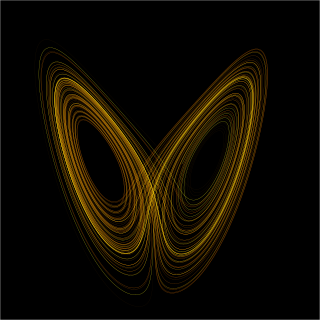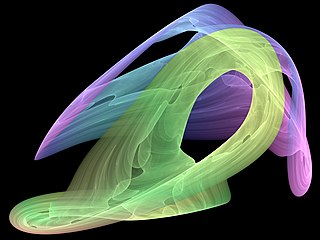
In dynamical systems, a branch of mathematics, a homoclinic connection is a structure formed by the stable manifold and unstable manifold of a fixed point.

In dynamical systems, a branch of mathematics, a homoclinic connection is a structure formed by the stable manifold and unstable manifold of a fixed point.
Let be a map defined on a manifold , with a fixed point . Let and be the stable manifold and the unstable manifold of the fixed point , respectively. Let be a connected invariant manifold such that
Then is called a homoclinic connection.
It is a similar notion, but it refers to two fixed points, and . The condition satisfied by is replaced with:
This notion is not symmetric with respect to and .
When the invariant manifolds and , possibly with , intersect but there is no homoclinic/heteroclinic connection, a different structure is formed by the two manifolds, sometimes referred to as the homoclinic/heteroclinic tangle. The figure has a conceptual drawing illustrating their complicated structure. The theoretical result supporting the drawing is the lambda-lemma. Homoclinic tangles are always accompanied by a Smale horseshoe.
For continuous flows, the definition is essentially the same.
When a dynamical system is perturbed, a homoclinic connection splits. It becomes a disconnected invariant set. Near it, there will be a chaotic set called Smale's horseshoe. Thus, the existence of a homoclinic connection can potentially lead to chaos. For example, when a pendulum is placed in a box, and the box is subjected to small horizontal oscillations, the pendulum may exhibit chaotic behavior.

In mathematics, a dynamical system is a system in which a function describes the time dependence of a point in an ambient space, such as in a parametric curve. Examples include the mathematical models that describe the swinging of a clock pendulum, the flow of water in a pipe, the random motion of particles in the air, and the number of fish each springtime in a lake. The most general definition unifies several concepts in mathematics such as ordinary differential equations and ergodic theory by allowing different choices of the space and how time is measured. Time can be measured by integers, by real or complex numbers or can be a more general algebraic object, losing the memory of its physical origin, and the space may be a manifold or simply a set, without the need of a smooth space-time structure defined on it.

In the mathematical field of dynamical systems, an attractor is a set of states toward which a system tends to evolve, for a wide variety of starting conditions of the system. System values that get close enough to the attractor values remain close even if slightly disturbed.
In mathematics, specifically in differential topology, Morse theory enables one to analyze the topology of a manifold by studying differentiable functions on that manifold. According to the basic insights of Marston Morse, a typical differentiable function on a manifold will reflect the topology quite directly. Morse theory allows one to find CW structures and handle decompositions on manifolds and to obtain substantial information about their homology.
In the mathematical field of differential geometry, a Cartan connection is a flexible generalization of the notion of an affine connection. It may also be regarded as a specialization of the general concept of a principal connection, in which the geometry of the principal bundle is tied to the geometry of the base manifold using a solder form. Cartan connections describe the geometry of manifolds modelled on homogeneous spaces.

In the mathematics of chaos theory, a horseshoe map is any member of a class of chaotic maps of the square into itself. It is a core example in the study of dynamical systems. The map was introduced by Stephen Smale while studying the behavior of the orbits of the van der Pol oscillator. The action of the map is defined geometrically by squishing the square, then stretching the result into a long strip, and finally folding the strip into the shape of a horseshoe.

The Rössler attractor is the attractor for the Rössler system, a system of three non-linear ordinary differential equations originally studied by Otto Rössler in the 1970s. These differential equations define a continuous-time dynamical system that exhibits chaotic dynamics associated with the fractal properties of the attractor. Rössler interpreted it as a formalization of a taffy-pulling machine.
In mathematics, more particularly in the fields of dynamical systems and geometric topology, an Anosov map on a manifold M is a certain type of mapping, from M to itself, with rather clearly marked local directions of "expansion" and "contraction". Anosov systems are a special case of Axiom A systems.

Bifurcation theory is the mathematical study of changes in the qualitative or topological structure of a given family of curves, such as the integral curves of a family of vector fields, and the solutions of a family of differential equations. Most commonly applied to the mathematical study of dynamical systems, a bifurcation occurs when a small smooth change made to the parameter values of a system causes a sudden 'qualitative' or topological change in its behavior. Bifurcations occur in both continuous systems and discrete systems.
In mathematics, specifically in the field of differential topology, Morse homology is a homology theory defined for any smooth manifold. It is constructed using the smooth structure and an auxiliary metric on the manifold, but turns out to be topologically invariant, and is in fact isomorphic to singular homology. Morse homology also serves as a model for the various infinite-dimensional generalizations known as Floer homology theories.

In the study of dynamical systems, a homoclinic orbit is a path through phase space which joins a saddle equilibrium point to itself. More precisely, a homoclinic orbit lies in the intersection of the stable manifold and the unstable manifold of an equilibrium. It is a heteroclinic orbit–a path between any two equilibrium points–in which the endpoints are one and the same.

In mathematics, in the phase portrait of a dynamical system, a heteroclinic orbit is a path in phase space which joins two different equilibrium points. If the equilibrium points at the start and end of the orbit are the same, the orbit is a homoclinic orbit.

In mathematics, and in particular the study of dynamical systems, the idea of stable and unstable sets or stable and unstable manifolds give a formal mathematical definition to the general notions embodied in the idea of an attractor or repellor. In the case of hyperbolic dynamics, the corresponding notion is that of the hyperbolic set.
In mathematics, Smale's axiom A defines a class of dynamical systems which have been extensively studied and whose dynamics is relatively well understood. A prominent example is the Smale horseshoe map. The term "axiom A" originates with Stephen Smale. The importance of such systems is demonstrated by the chaotic hypothesis, which states that, 'for all practical purposes', a many-body thermostatted system is approximated by an Anosov system.
In mathematics, especially in the study of dynamical systems and differential equations, the stable manifold theorem is an important result about the structure of the set of orbits approaching a given hyperbolic fixed point. It roughly states that the existence of a local diffeomorphism near a fixed point implies the existence of a local stable center manifold containing that fixed point. This manifold has dimension equal to the number of eigenvalues of the Jacobian matrix of the fixed point that are less than 1.
In mathematics, the Melnikov method is a tool to identify the existence of chaos in a class of dynamical systems under periodic perturbation.
In mathematics, the Riemannian connection on a surface or Riemannian 2-manifold refers to several intrinsic geometric structures discovered by Tullio Levi-Civita, Élie Cartan and Hermann Weyl in the early part of the twentieth century: parallel transport, covariant derivative and connection form. These concepts were put in their current form with principal bundles only in the 1950s. The classical nineteenth century approach to the differential geometry of surfaces, due in large part to Carl Friedrich Gauss, has been reworked in this modern framework, which provides the natural setting for the classical theory of the moving frame as well as the Riemannian geometry of higher-dimensional Riemannian manifolds. This account is intended as an introduction to the theory of connections.
In dynamical systems theory, an area of pure mathematics, a Morse–Smale system is a smooth dynamical system whose non-wandering set consists of finitely many hyperbolic equilibrium points and hyperbolic periodic orbits and satisfying a transversality condition on the stable and unstable manifolds. Morse–Smale systems are structurally stable and form one of the simplest and best studied classes of smooth dynamical systems. They are named after Marston Morse, the creator of the Morse theory, and Stephen Smale, who emphasized their importance for smooth dynamics and algebraic topology.
A normally hyperbolic invariant manifold (NHIM) is a natural generalization of a hyperbolic fixed point and a hyperbolic set. The difference can be described heuristically as follows: For a manifold to be normally hyperbolic we are allowed to assume that the dynamics of itself is neutral compared with the dynamics nearby, which is not allowed for a hyperbolic set. NHIMs were introduced by Neil Fenichel in 1972. In this and subsequent papers, Fenichel proves that NHIMs possess stable and unstable manifolds and more importantly, NHIMs and their stable and unstable manifolds persist under small perturbations. Thus, in problems involving perturbation theory, invariant manifolds exist with certain hyperbolicity properties, which can in turn be used to obtain qualitative information about a dynamical system.
In mathematics, particularly in the study of functions of several complex variables, Ushiki's theorem, named after S. Ushiki, states that certain well-behaved functions cannot have certain kinds of well-behaved invariant manifolds.
In the mathematical field of quantum topology, the Reshetikhin–Turaev invariants (RT-invariants) are a family of quantum invariants of framed links. Such invariants of framed links also give rise to invariants of 3-manifolds via the Dehn surgery construction. These invariants were discovered by Nicolai Reshetikhin and Vladimir Turaev in 1991, and were meant to be a mathematical realization of Witten's proposed invariants of links and 3-manifolds using quantum field theory.